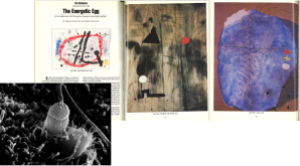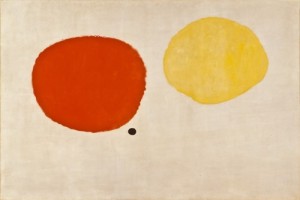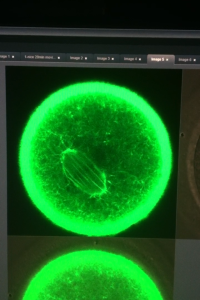I have never quite gotten surrealist, post-modern art. (Left to my own devices I happily spend my museum visits floating around the impressionist era.) I look at abstract symbolic paintings and feel that I miss the intended emotion or meaning—as if the painters and their devotees speak a language I cannot understand.
That changed when I stumbled upon an ephemeral relationship between the art of Miró and fertilization research from the early 1980s to mid 1990s. This connection provided me with a whole new way to view, understand, and appreciate Miró. His art was no longer a remote, confusing abstraction, but rather an artistic reflection of the same questions about life, reproduction, and behavior I think about as a scientist.
It all started with a magazine article written by two incredible scientists, Gerald and Heidi Schatten in 1983.[i] (Fun fact, Gerald Schatten and I both attended Stuyvesant High School in NYC, albeit about 50 years apart). The Schattens illustrate the history of research in fertilization starting from Hippocraties, and the paucity of information about the female gamete that persisted until the late 1800s. As scientists probed the mysteries of the egg they found it was active in the fertilization process and discovered intricate mechanisms through which the egg cooperates to bring the sperm through its layers, fuse the maternal and paternal nuclei, and initiate development. New microscopic technologies revealed the complex internal structure of the egg that facilitates many of these key fertilization events.
In addition to describing research for a public audience, the article also included three paintings by Joan Miró, as well as works by Alexander Calder and Pablo Picasso. Nothing in the text describes the art. They are just there: full page, color reproductions, with no explanation. However, when I looked at the paintings included in the article alongside the Schattens’ scientific images of the earliest moments of sea urchin fertilization, I understood. The spherical shapes evoke the female gamete. In the painting Amour, the letters spelling the title spill out from a point on the large purple/blue shape that could be the site of fertilization. The flurry of lines, dots and shapes within the red circle of The Broken Circle captures the energetic egg paradigm the Schattens describe.
I was curious why Miró’s paintings, in particular, had been included in the article. I turned to Google, searching for something that might explain the connection between his work and reproductive biology. Although nothing on the Internet provided me with a conclusive answer, I did uncover additional incidents where Miró and fertilization research intersected.
I found an article from the Chicago Tribune in 1990 about the scientist Yury Verlinsky’s discovery of a new in vitro technology for genetic testing.[ii] If a couple is worried about having a baby because of a genetic disorder that could be inherited, Dr. Verlinsky’s technique would allow scientists to test the egg for the disease before it is even fertilized. The test is performed on DNA of the polar body, part of the egg that is extruded in the cellular divisions during maturation, and determines whether or not a baby made from that egg would inherit the genetic disorder. The article described that Dr. Verlinsky came up with the idea looking at a Miró painting:
“Relaxing after a day spent pondering the earliest stages of fetal development, Verlinsky visited a Jerusalem art gallery. He contemplated an untitled 1935 painting by the great Spanish abstractionist, Joan Miró. In Miró’s typically droll style, the painting consisted of two disks floating in space, one red, the other yellow. Just underneath the red disk was another round object, black and very tiny. Verlinksy stood and stared for a long time. The more he examined Miró’s colored disks, the more they looked to him like human eggs. Maybe the red disk became the yellow disk after it kicked out the black dot, he mused. “
I became obsessed; I needed to see the painting that had inspired the flash of genius to test polar bodies. The paltry clues included in the article were of little help. I acquired the entire catalogue of Miró’s paintings[iii] and scoured through 1935, staring at anything with even a close resemblance to the description, but nothing matched. As I resigned myself to work through Miró’s entire collection, I worried that I would accidentally skip over or not recognize the painting. My fears were unfounded. I knew immediately when I came to the The Magic of Color, 1930 that I had found it. To me, it was definitely not droll. It was glorious.
However, I was still not satisfied. I delved deeper into the pages of my Google search results until I came across a sentence in An Intimate Distance: Women, Artists and the Body by Rosemary Betterson[iv] that told of an exhibition in 1992, organized by the Joan Miró Foundation[v] on In Vitro fertilization. I scoured the recesses of the Internet to find any reference of this exhibit and came up empty handed. I was ultimately able to get my hands on both the exhibit catalogue[vi] and record of the accompanying symposium.[vii] The exhibition In vitro. From the mythology of fertility to the boundaries of science, initiated by KRTU a cultural branch of the Catalan government, was not explicitly about Miró; rather, it explored the boundary between science, history, and art in our relationship with fertility.
“We have arranged the exhibition in such a way as to show, through various nuclei, the traces and faces (archaeological, linguistic, gastronomic, artistic, ethnographic, scientific, etc.) of fertility myths, the current situation in the fight against infertility, and the prospects current research is now opening up.” – Vicenc Altaio and Anna Viega, Curators of In Vitro. 8
Pages away from each other are the Venus statues of early humans and ancient Greeks, Miró’s bronze figures of women that emphasize female secondary sexual characteristics, and tools used by midwives and obstetricians. The speculums and dilators are so structurally intricate they are at home alongside the famous sculptures. Powerpoint slides on IVF technologies that could have been pulled directly from a course in reproductive biology for conservation I took while studying abroad are nearly touching reproductions of the Virgin Mother and Child.
As a post baccalaureate fellow in the lab of Dr. Carmen Williams at the NIEHS [viii] I learned how to do in vitro fertilization of mice. I manipulated micropipettes with a joystick to hold and inject eggs in order to change their gene expression. I spent so many hours mouth-pipetting ooctytes to remove the cells that surround them when they are collected from the ovary that I would get home, close my eyes, and see them imprinted on my eyelids. In the In vitro exhibit the same images I saw, starting down a microscope, were suddenly art. Were discussed in the same breath as the biological drawings of Erns Haeckel and the renowned paintings of Picasso, Dali, and Miró.
“The beauty of the scientific images and the beauty of the artistic images – even if we are unable to read them when we are unfamiliar with their code – would suffice by themselves to justify the exhibition…”
– Vicenc Altaio and Anna Viega, Curators of In Vitro.8
My winding exploration of Miró provided me with an entirely new perspective of not only surrealist art, but also the aesthetics of my own research. More than that, Miró’s paintings reminded me of the humanity of my research. Although we are using different techniques, terminology, and mediums, fundamentally I ask the same questions about how life begins. If I am receptive to it, I can find the themes of my research in reproduction reflected throughout culture. For these reasons, and so many more, it delights me that the acronym for artificial reproductive technologies is ART.
P.S. If anyone reading this is computer programming inclined, I desperately require an app that will allow me to use Miró symbols as emoji’s. I’ll call them: Miróji’s.
Figure 1: Miro, 1967. The Gold of the Azure. http://www.fundaciomiro-bcn.org/coleccio_obra.php?idioma=2&obra=709
Figure 2: Bottom left – G. Schatten, scanning electron micrograph (SEM) image of sea urchin fertilization http://worms.zoology.wisc.edu/dd2/echino/fert/pronuclear/pronuclear.html Top are from 1. Left – Miro, 1964. The Broken Circle. Center – Miro, 1925. The Birth of the World. Right – Miro, 1926. Amour.
Figure 3: Miro, 1930. The Magic of Color. http://catalogue.successiomiro.com/catalogues/paintings-i/painting-the-magic-of-color.html
Figure 4: McDonough, C.E. and Bernhardt, M. MII egg GFP experiments.
[i] Schatten, G. and Schatten, H. 1983. The Energetic Egg. The Sciences.
[ii] Gorner, P. and Kotulak, R. 1990. Gene Screening: A Chance to Map Our Body’s Future. Chicago Tribune. http://articles.chicagotribune.com/1990-04-15/news/9001310515_1_genetic-yury-verlinsky-gene-screening
[iii] Dupin, J and Lelong-Mainaud, A. 2003. Catalogue raisonné. Paintings. Vol. I – VI. Successió Miró A.D.A.G.P., Paris.
[iv] Betterton, R. 1996. An Intimate Distance: Women, Artists and the Body. Routledge.
[v] http://www.fundaciomiro-bcn.org/fundaciojoanmiro.php?idioma=2
[vi] Altaio, V. and Viega, A. curators 1992. In Vitrode les mitologies de la fertilitat als limits de la cencia. Fundació Joan Miró, Barcelona.
[vii] Altaio, V. and Viega, A. curators 1992. In vitro a Debat Simposi. Fundació Joan Miró, Barcelona.
[viii]http://www.niehs.nih.gov/research/atniehs/labs/rdbl/pi/reproductive/index.cfm
Caitlin McDonough is a first year biology graduate in the Center for Reproductive Evolution. When not dissecting fruit flies, she plays rugby, draws and disrupts conventional scientists by talking about feminism and queer studies. More information can be found at her website cemcdonough.com or fledgling blog ideaspermatheca.com.




